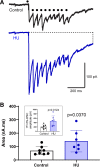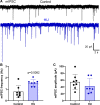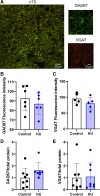Cardiovascular deconditioning increases GABA signaling in the nucleus tractus solitarii
- PMID: 35642806
- PMCID: PMC9236861
- DOI: 10.1152/jn.00102.2022
Cardiovascular deconditioning increases GABA signaling in the nucleus tractus solitarii
Abstract
The nucleus tractus solitarii (nTS) is the major integrative brainstem region for autonomic modulation and processing of cardiovascular reflexes. GABA and glutamate are the main inhibitory and excitatory neurotransmitters, respectively, within this nucleus. Alterations in the GABA-glutamate regulation in the nTS are related to numerous cardiovascular comorbidities. Bedridden individuals and people exposed to microgravity exhibit dysautonomia and cardiovascular deconditioning that are mimicked in the hindlimb unloading (HU) rat model. We have previously shown in the nTS that HU increases glutamatergic neurotransmission yet decreases neuronal excitability. In this study, we investigated the effects of HU on nTS GABAergic neurotransmission. We hypothesized that HU potentiates GABA signaling via increased GABAergic release and postsynaptic GABA receptor expression. Following HU or control postural exposure, GABAergic neurotransmission was assessed using whole cell patch clamp whereas the magnitude of GABA release was evaluated via an intensity-based GABA sensing fluorescence reporter (iGABASnFR). In response to GABA interneuron stimulation, the evoked inhibitory postsynaptic current (nTS-IPSC) amplitude and area, as well as iGABASnFR fluorescence, were greater in HU than in control. HU also elevated the frequency but not the amplitude of spontaneous miniature IPSCs. Picoapplication of GABA produced similar postsynaptic current responses in nTS neurons of HU and control. Moreover, HU did not alter GABAA receptor α1 subunit expression, indicating minimal alterations in postsynaptic membrane receptor expression. These results indicate that HU increases GABAergic signaling in the nTS likely via augmented release of GABA from presynaptic terminals. Altogether, our data indicate GABA plasticity contributes to the autonomic and cardiovascular alterations following cardiovascular deconditioning (CVD).NEW & NOTEWORTHY Gravity influences distribution of blood volume and autonomic function. Microgravity and prolonged bed rest induce cardiovascular deconditioning (CVD). We used hindlimb unloading (HU), a rat analog for bed rest, to investigate CVD-induced neuroplasticity in the brainstem. Our data demonstrate that HU increases GABA modulation of nucleus tractus solitarii (nTS) neurons via presynaptic plasticity. Given the importance of nTS in integrating cardiovascular reflexes, this study provides new evidence on the central mechanisms behind CVD following HU.
Keywords: IPSC; autonomic nervous system; hindlimb unloading; synaptic transmission.
Conflict of interest statement
No conflicts of interest, financial or otherwise, are declared by the authors.
Figures








Similar articles
-
Mechanisms Underlying Neuroplasticity in the Nucleus Tractus Solitarii Following Hindlimb Unloading in Rats.Neuroscience. 2020 Nov 21;449:214-227. doi: 10.1016/j.neuroscience.2020.09.043. Epub 2020 Oct 9. Neuroscience. 2020. PMID: 33039526 Free PMC article.
-
Depressed GABA and glutamate synaptic signaling by 5-HT1A receptors in the nucleus tractus solitarii and their role in cardiorespiratory function.J Neurophysiol. 2014 Jun 15;111(12):2493-504. doi: 10.1152/jn.00764.2013. Epub 2014 Mar 26. J Neurophysiol. 2014. PMID: 24671532 Free PMC article.
-
α-MSH exerts direct postsynaptic excitatory effects on NTS neurons and enhances GABAergic signaling in the NTS.Neuroscience. 2014 Mar 14;262:70-82. doi: 10.1016/j.neuroscience.2013.12.039. Epub 2013 Dec 25. Neuroscience. 2014. PMID: 24370637
-
Autonomic processing of the cardiovascular reflexes in the nucleus tractus solitarii.Braz J Med Biol Res. 1997 Apr;30(4):533-43. doi: 10.1590/s0100-879x1997000400015. Braz J Med Biol Res. 1997. PMID: 9251775 Review.
-
Glutamatergic neurotransmission in the nucleus tractus solitarii: structural and functional characteristics.J Chem Neuroanat. 2009 Nov;38(3):145-53. doi: 10.1016/j.jchemneu.2009.03.004. Epub 2009 Mar 28. J Chem Neuroanat. 2009. PMID: 19778680 Review.
Cited by
-
Oxytocin and corticotropin-releasing hormone exaggerate nucleus tractus solitarii neuronal and synaptic activity following chronic intermittent hypoxia.J Physiol. 2024 Jul;602(14):3375-3400. doi: 10.1113/JP286069. Epub 2024 May 3. J Physiol. 2024. PMID: 38698722 Free PMC article.
-
Kv2 channels contribute to neuronal activity within the vagal afferent-nTS reflex arc.Am J Physiol Cell Physiol. 2024 Jan 1;326(1):C74-C88. doi: 10.1152/ajpcell.00366.2023. Epub 2023 Nov 20. Am J Physiol Cell Physiol. 2024. PMID: 37982174 Free PMC article.
-
Selective breeding for physical inactivity produces cognitive deficits via altered hippocampal mitochondrial and synaptic function.Front Aging Neurosci. 2023 Apr 3;15:1147420. doi: 10.3389/fnagi.2023.1147420. eCollection 2023. Front Aging Neurosci. 2023. PMID: 37077501 Free PMC article.
References
Publication types
MeSH terms
Substances
Grants and funding
LinkOut - more resources
Full Text Sources
Research Materials

